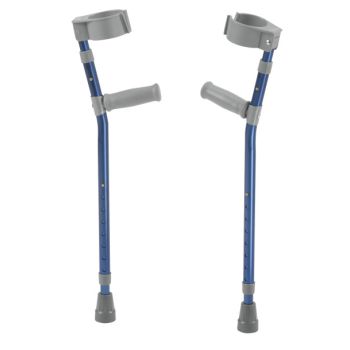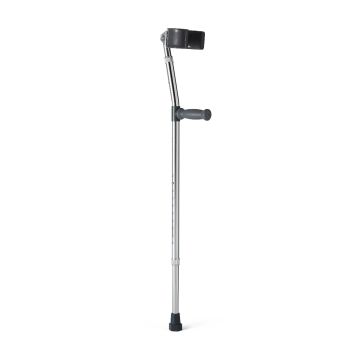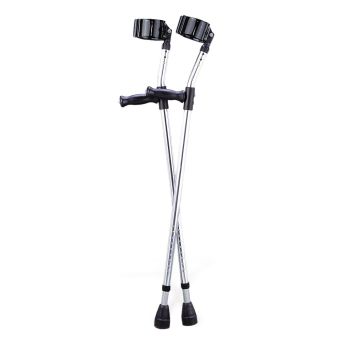Free shipping orders over $50
Losfstrand Crutches / Arm Crutches
Forearm crutches are an effective long term crutch solution for many. These go by many different names, but whether you refer to them as lofstrand crutches, arm crutches, or Canadian crutches, or even elbow crutches, these crutches share a purpose: They are designed to help promote support and stability in order to help users with mobility. AvaCare Medical has some of the best forearm crutches available, from companies such as Graham Field, Drive Medical, and Medline! Read More...
-
Pediatric Forearm Crutches
Starting at $88.40 -
Medline Forearm Crutches
Starting at $35.55 -
Guardian Forearm Crutches
Starting at $40.48 -
Lightweight Forearm Crutches
Starting at $75.40
What Are Forearm Crutches?
Lofstrand crutches are made differently than typical (axillary) crutches. Rather than having a support positioning under the user’s armpit, forearm canes find their support in the forearm in order to distribute the weight more evenly throughout the arms instead of just from the wrist alone. They’re excellent in helping users suffering from long-lasting musculoskeletal problems (such as muscular dystrophy, polio, or arthritis), and in fact, they were invented in the 1950s by Thomas Fetterman, a polio survivor. He created this version by modifying the original A.R. Lofstrand adjustable crutch to improve his own mobility. Since then, his invention has become quite popular, and is now made in different styles and from different materials.
Benefits of Forearm Crutches
Forearm canes offer a lot more benefits than axillary crutches when it comes to long-term or chronic injuries. While some people would rather have the familiarity that underarm crutches offer, there are many reasons to consider purchasing wrist crutches instead. Some of the benefits of cuff crutches are:
Posture Relief and Correction
Many users of crutches have to lean forward while using them, which is something of a given. With underarm (or axillary) crutches, many users hunch over and end up bending their spine, which can lead to discomfort and poor posture. Using forearm crutches (such as our black forearm crutches) can help the user to improve posture because, even when leaning forward, many users can keep their spine straighter. By keeping the spine straight even while leaning forward, there is reduced strain on the body’s core overall, and lower impact to the spine and legs.
Axillary Nerve Safety
Underarm crutches are often uncomfortable for many users, even if used correctly. Part of this is due to the pressure on the axillary nerves that the top pad puts on the user’s arms. By walking with forearm crutches, a user can reduce the pressure on the axillary nerve and possibly avoid nerve damage that has been known to happen at times with underarm crutches.
More Ergonomic
Crutches with arm cuffs distribute the weight evenly on the hands, wrists, and forearms; they don’t put all of the weight-bearing on a user’s hands and wrists. The handles of Lofstrand forearm crutches are more ergonomic than underarm crutches. Combined with the forearm support braces, Canadian forearm crutches alleviate pressure on just one select area of the arm. This makes forearm cane crutches a perfect walking aid for seniors and those who suffer from arthritis.
More Lightweight than Underarm Crutches
Most standard axillary crutches (with a 300 pound capacity) weigh about 5 pounds. While some forearm crutches can weigh this much, many of them are even lighter because of their reduced frame and the lightweight nature of the materials that are used in manufacturing. Elbow support crutches are able to provide the same weight-bearing abilities that other crutches can withstand as well – our models of forearm crutches for sale range in support from 200 pounds all the way up to 500 pounds.
More Comfortable
Due to the ergonomic grips and the frame and arm support that are provided by using elbow crutches, users can have a more comfortable experience. Using crutches under the arm can trigger friction, and this can cause not only discomfort but also chafing and skin irritations from clothes gathering into the user’s armpit. When walking with arm crutches, there is no friction from clothing, and many times, the forearm braces don’t slide around to cause problems and discomfort for the user either.
Promotes Physical Strength
While using any type of crutch does require some physical strength, it should be noted that using arm canes as crutches with arm support can require a little bit more upper body strength and also help build and promote such strength. Users must hold their arms a certain way in order to use forearm support crutches in a way that will increase muscle strength and limit atrophy. Along with upper body strength, using elbow crutches while walking can help to combat atrophy of the lower limbs as well when possible. The longer a user uses Canadian crutches for sale, the more physical strength they will attain.
Improved Cardiovascular Functionality
It has been proven medically that armpit crutches can contribute to a higher heart rate than seen in users who are walking with loft strand crutches. Those who buy forearm crutches and use them regularly experience not only greater physical strength and muscle build, but also have lower heart rates and lower blood pressure, which can indicate better cardiovascular health overall.
How to Use Forearm Crutches
Many people want to know how to walk with crutches both while bearing weight and without weight bearing. Using crutches without bearing on one’s legs calls for different methods than the way standard crutches are used. Many elbow crutches for sale have manuals which explain how to use them like a cane with forearm support – even cheap forearm crutches (which does not mean low-quality; only affordable). Most users compare elbow walking sticks to using an offset-handled cane, although walking canes don’t offer the same wrist and forearm support
With an elbow walking stick, the wrist is the point of pivot instead of the axilla (or underarm). As mentioned earlier, Lofstrand crutches use the upper body more, but the weight bearing is distributed more evenly throughout the arms and even the chest. Users do need to know whether or not they have the physical strength to walk with these without falling. If a person buys forearm crutches, they must be able to exercise some degree of balance; otherwise, they should look into buying a wheelchair. The best way to walk with forearm crutches is to:
1. Adjust the crutches appropriately.
2. Adjust the cuffs so they fit comfortably on the forearm.
3. Put both crutches forward about 12 inches in front of the body, and put the uninjured foot forward first.
4. Next, put weight down on the crutches and move the body forward while raising the injured foot off of the ground.
5. Take time and be careful while walking each step to ensure maximum balance remains constant.
If you were wondering where to buy forearm crutches for sale, you’ve probably figured out the answer by now - AvaCare Medical! We have extremely durable lofstrand crutches that can withstand the tests of time. If you have any questions, we are here to answer them. All of our highly-trained and professional staff are ready to assist you with your order or speak with you about any concerns you have. Simply give us a call at 1-877-813-7799, send an email, or chat with an experienced customer care girl now!






